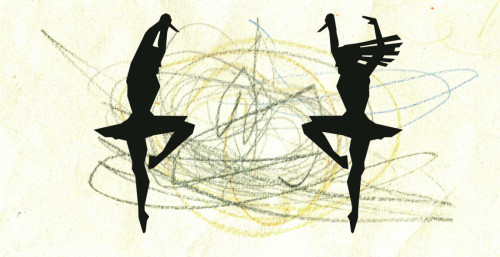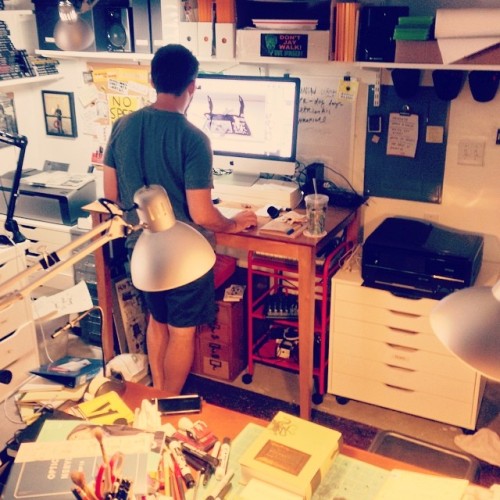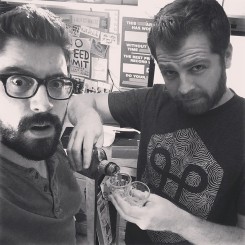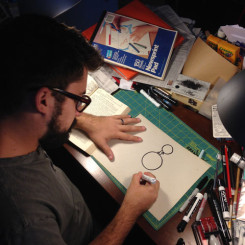Last Friday I played designer Kelli Anderson in a match of Layer Tennis, moderated by Jason Kottke. You can see the whole match unfold here.
It was definitely one of the most intense afternoons I’ve had in a while. I used to hate playing in competitive sports. The only sports I ever enjoyed taking part in were pretty solitary: golf and long distance running. Practicing both of those sports, mostly you’re just trying to beat your own score or time. (Honestly, I hated them, too. Just not a sports dude.)
I think one reason I’m drawn to writing and art is that I don’t have to be competitive — if I’m competing with anyone, it’s against myself, or a bunch of my favorite (most of them dead) artists, or it’s a kind of friendly competition spurred on by seeing other folks’ work in the world. And even then, I’m not competing to be the best at what I do, I’m trying to be the only one who does what I do.
But there was something about the combination of the pressure of the match and what Kelli threw at me that pushed me to come up with stuff I wouldn’t have come up with otherwise…
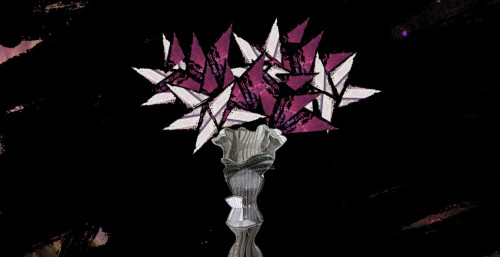
There was one particular moment at the end when I was making my last volley, where I was a few drinks in, Kelli had thrown me something that seemed impossible to respond to, and so I just went to that “zone” or “flow state” that you hear people talk about, where I just started pushing shapes around, seeing something appear as if someone else was making it. The throwing star bouquet didn’t really wow anybody (Kottke called it “not the strongest finish”) but I loved it. It was weird and sort of fucked up and it was so different than anything I usually make. I thought it tied up things nicely — a little romance and violence.
So, that’s the first thought: competing against Kelli, knowing she was going to respond, knowing that all these other people were going to judge what I sent back, that pushed me into a space I don’t normally occupy.
But something else was different, too: my good buddy Gerren Lamson was in the studio with me all morning for moral support, cheering me on, serving me alcohol, etc. This gave the studio a different vibe: I spend so much of my days alone out in the garage, it is really, really wonderful to have someone else in the studio, not really to even bounce ideas off of, but just for the company. There’s something about just having another warm body in the room that really helped. (Keep in mind, I’m an extreme extrovert.)
Afterwards, I was reminded of this passage from the book Powers of Two:
John Lennon… was so devoid of an internal relation that he had a hard time being by himself. “His reclusive lifestyle notwithstanding,” his friend Pete Shotton said, “John could never bear to be left completely alone — even when he was composing his songs. Much of my time at Kenwood was spent idly reading or watching TV while John, a few feed away, doodled at the piano or scribbled verses on a scrap of paper.” “If I am on my own for three days, doing nothing, “ [Lennon] told Hunter Davies in 1967, “I’m just not here…I have to see the others to see myself.”
I brought up this subject with a songwriter acquaintance of mine, and he told me the same thing: sometimes when he’s writing a song, he likes to have a buddy with him in the room, not for direct input, but just to be there — having another person in the room, helps him imagine an audience for what he’s writing, and sort of judge the material accordingly.
A little off topic, maybe, but here’s Quentin Tarantino, on reading his screenplays to his friends aloud:
I don’t want input, I don’t want you to tell me if I’m doing anything wrong, heavens forbid. But I write a scene, and I think I’ve heard it as much as I can, but then when I read it to you . . . I hear it through your ears, and it lets me know I’m on the right track.
I’ve resisted co-working for a really long time, mainly because I’m cheap, and I like my space, but that idea has stuck with me — just having another body in the room I think puts me in a different mindset when I’m working.
Something to explore and think about further…
